|
Recent Entries to this Blog
Is It Really.....?
Posted: 16 Mar 2015 Posted: 06 Oct 2014 Posted: 29 Aug 2014 Posted: 28 Aug 2014 Posted: 30 Jul 2014 All Entries |
Jewell's BlogRamblings from the Puget Sound
Berry Time
Category: Summer | Posted: Fri Jun 27, 2014 6:08 pm Berry time is a little late in my yard this year. We usually get our first blueberry close to The last week of May, not June. That is just fine because I have never seen so many berry on the producing blueberry bush. 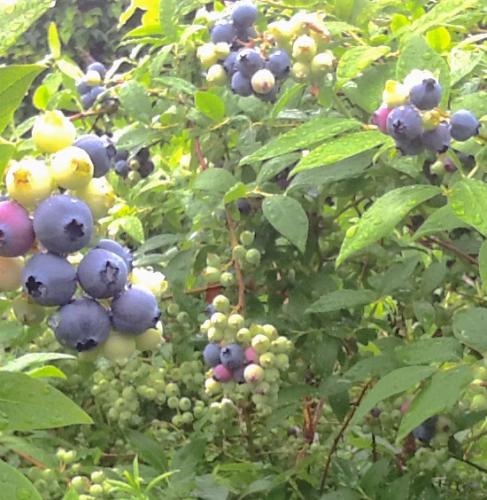
Blueberries ( photo / image / picture from Jewell's Garden ) That one bush will keep me busy picking berries most of the summer. The other three blueberry bushes have been revitalized by a hard pruning last summer. They are now three times the size they were before. Next year those bushes will be great producers too. The last two years I have bought two blueberry bushes each year. The first two bushes are already three to four feet tall. With judicious pinching back we will hopefully be freezing much more of the blueberries we consume. A berry that takes a little more work, but we enjoy are the raspberries. Unfortunately they are easily damaged by rain. We had some measurable rains today. This week and most of the spring I have been managing the new raspberry plants that sprout all around the parent plants. Some are even six feet away. They are still tasty, just a lot more work than blueberries to maintain. 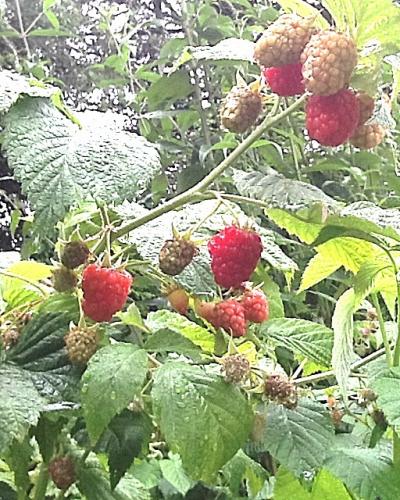
Raspberries ( photo / image / picture from Jewell's Garden ) The last berries we have are strawberries. They produce the least and I am just not very successful with them. There are a variety of reasons. Lack of light and warmth might contribute to part of the problem. Slugs are another problem, but using shredded cedar mulch has helped a lot with those varmints. But the cedar doesn't help with the main varmint ...... 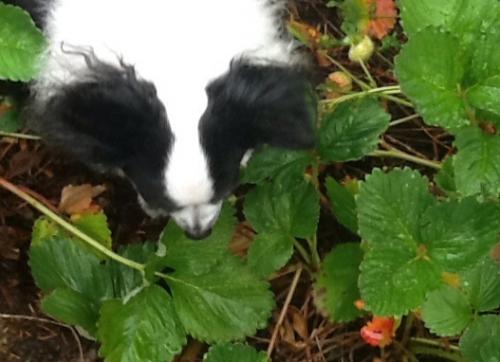
Varmint in berries ( photo / image / picture from Jewell's Garden ) 
Max....his guilty look ( photo / image / picture from Jewell's Garden ) How could I refuse him strawberries? Someone needs to pick the lower berries. This blog entry has been viewed 346 times
Thrift Store, Huglekultur, Bokashi, Mutants and More
Category: Starting and Maintaining the Garden | Posted: Tue Jun 24, 2014 6:28 pm Have spent the last week painting and weeding and digging. Even made a couple of trips to the thrift store. Everything goes slowly as I wander from one task to another with many thoughtful or is it thoughtless moments. The perfect life to be sure. The thrift store provided a third chair for the smoke shack. With less than 60 square feet it now provides comfortable seating for three. I still believe I could get a fourth chair in, but hubby wants plenty go room for the heater and old table in the last corner. The fourth person will have to sit on the ottoman...if they can squish in. 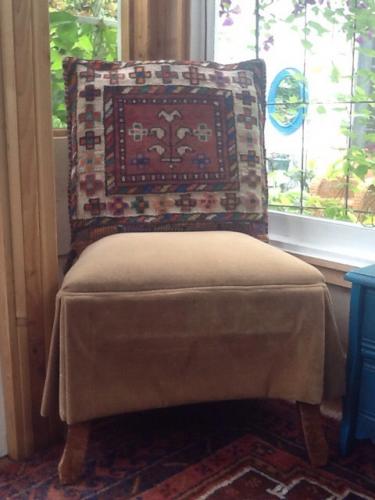
New chair for smoke shack ( photo / image / picture from Jewell's Garden ) 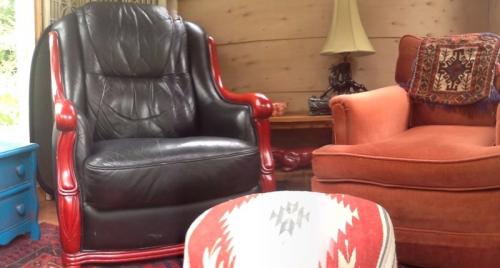
The other seating ( photo / image / picture from Jewell's Garden ) Ciara took a moment to excavate the Huglekultur. Some city critter had obviously caught her attention and she moved some of the soil to reveal huge open spaces within the mound. There had obviously been a great deal of settling. This forced me to continue leveling (removing soil) from another area to use as fill around some of the logs in the Huglekultur. What was intriguing to me was one of the logs on top that was only half buried. Some mustard greens I had planted were well rooted through the dirt into the bark of the log. The log was full of moisture and quite heavy for its size. The tomatoes seem to be doing well, but haven't set fruit. The cucumbers, squash and bush beans are coming along. Whatever is produced will be gratefully appreciated, even if it just turns out to be green manure. This first spring is just an experiment since it should have been started the previous fall or summer for everything to settle. 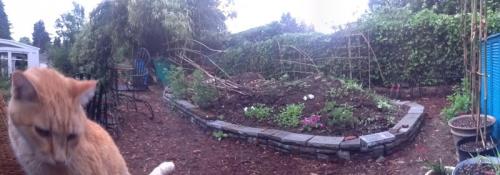
Huglekultur with Buddy in foreground ( photo / image / picture from Jewell's Garden ) 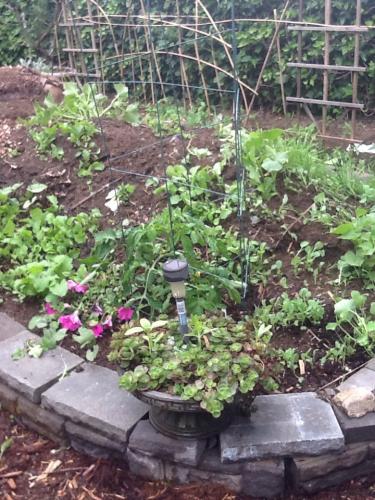
Greens, etc. on Huglekultur ( photo / image / picture from Jewell's Garden ) 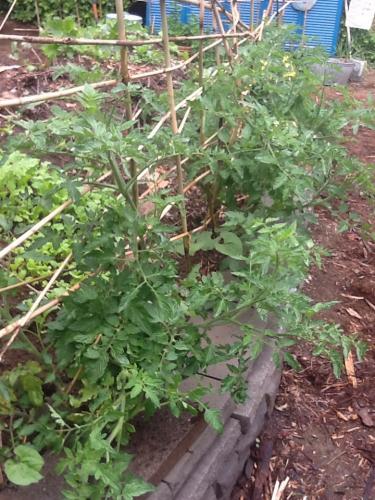
Tomatoes on the Huglekultur ( photo / image / picture from Jewell's Garden ) Have a couple of mutants that cause a bit of reading and curiosity on my part. The first is a hosta. When I bought it it was just like the two in front. The first year I planted it more in the sun and the color changed. I had thought it was because of the sunlight. When I moved it to the shade early this spring it retained the large blue with smaller cream pattern. It is the hosta in the far back. It is hard to believe they all looked exactly the same at one time. I find hostas intriguing. With the thousands of varieties and hundreds of species and all the cross breeding being done it is totally mind boggling and small wonder the poor plants can't decide what color they are. 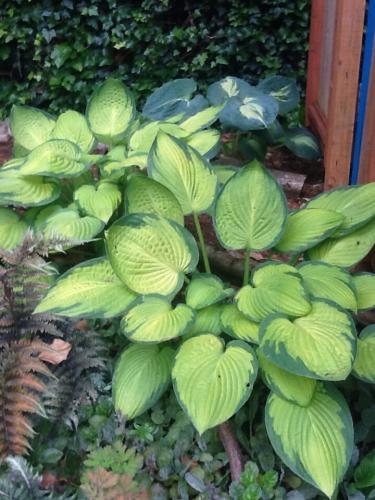
Mutated hosta... ( photo / image / picture from Jewell's Garden ) My other variation of a plant is a plumeria clump. One plant in the clump has a very silver leaf rather than the spotted variety. I will be separating it from the clump this week. It is so pretty I was thinking of giving it a pot of its own. 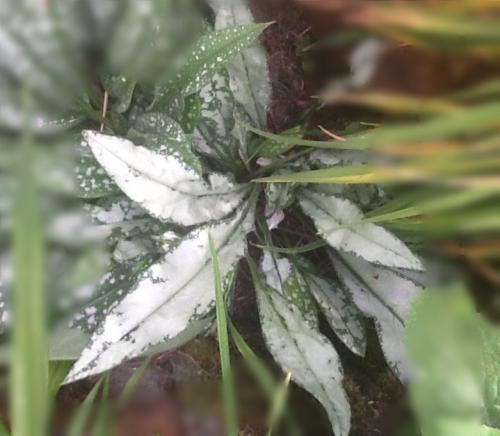
Pulmaria variation ( photo / image / picture from Jewell's Garden ) Now for the update on one of my other experiments, bokashi. The dogs love it no matter what I do to hide it and will dig it up no matter how deep I plant it. Like blood meal not an easy organic to use if you live with animals in a city full of critters. My other purchase from the thrift store were two metal pails with locking lids. Layers of dirt and bokashi pickled house scraps went into the buckets. We will see if they turn to compost in a few weeks. If not this may not be a viable solution for this household. On a brighter note the miniature rose I got off the sale rack after Valentine's Day are blooming and good sizes bushes. 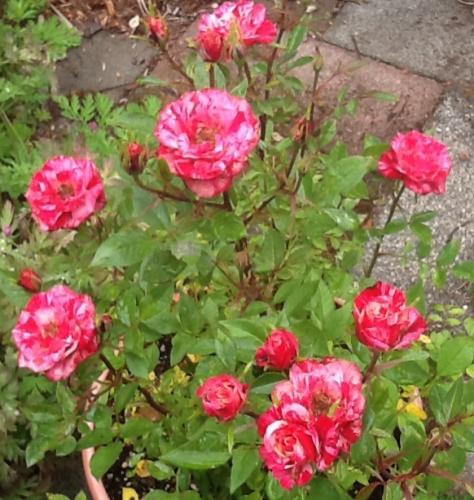
Bicolored mini rose ( photo / image / picture from Jewell's Garden ) 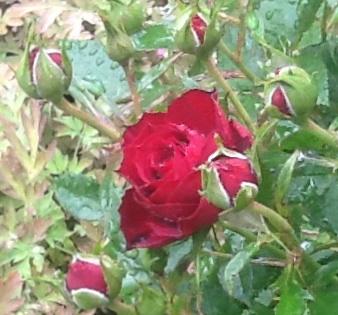
Red mini rose ( photo / image / picture from Jewell's Garden ) 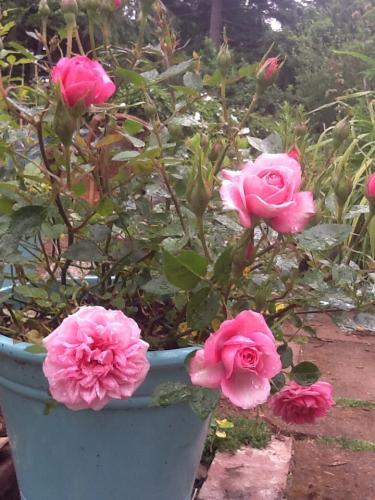
My favorite mini rose ( photo / image / picture from Jewell's Garden ) My favorite combinations in the garden at the moment 
( photo / image / picture from Jewell's Garden ) 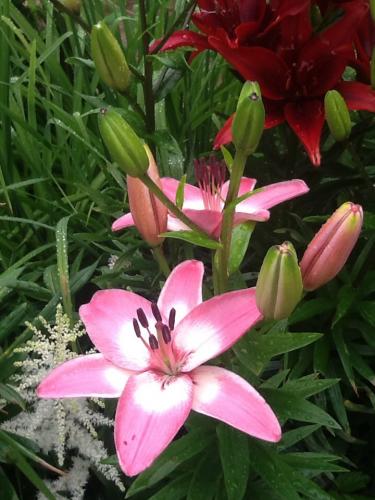
Noid lilies ( photo / image / picture from Jewell's Garden ) 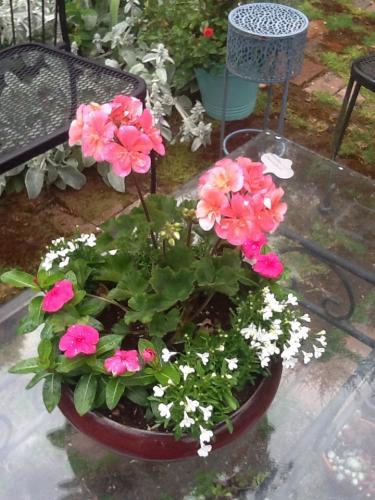
Little planter ( photo / image / picture from Jewell's Garden ) I will close with my last thrift store purchase. May your day have many peaceful moments woven into it. 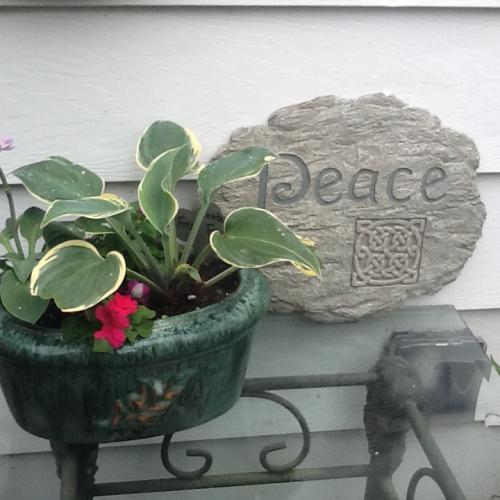
A last little thrift show find (first frost and blue mouse ears hostas in planter) ( photo / image / picture from Jewell's Garden ) This blog entry has been viewed 336 times
June Garden
Category: Starting and Maintaining the Garden | Posted: Fri Jun 06, 2014 6:39 am The miniature bearded iris were all moved to the front yard. I removed pavers to plant them in the patio area. I lost three varieties this spring because of the plants being new with incredibly heavy rains this spring. I had hoped to save some but only one looks like it might recover from the rot. Of the three two were reblooming varieties. Only the yellow one was unaffected. The front yard is the driest area with fairly sandy soil. All the transplanted iris look good and only one wilted from the move. The foxgloves are in bloom. They are quite short this year. No twelve foot monsters. Many are only two feet and most are four to five feet. I am very pleased with the woodland garden. Am having a small garden party on Saturday. The tables are in place and the winter dirt has been scrubbed off. Just a few friends over for sandwiches and conversation. 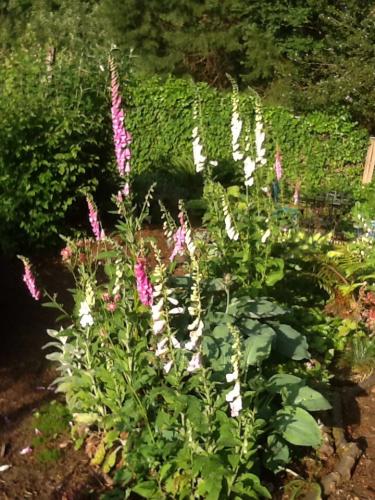
Foxgloves ( photo / image / picture from Jewell's Garden ) The woodland garden has really grown and is a pleasure able place to listen to the morning bird songs. Here is a walk around. Hope you have your favorite beverage in hand. 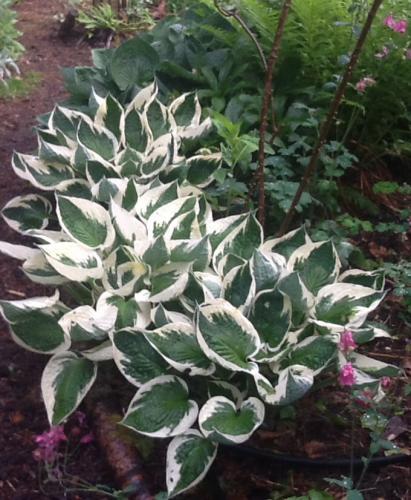
Patriot hostas ( photo / image / picture from Jewell's Garden ) 
( photo / image / picture from Jewell's Garden ) 
( photo / image / picture from Jewell's Garden ) 
( photo / image / picture from Jewell's Garden ) 
( photo / image / picture from Jewell's Garden ) 
( photo / image / picture from Jewell's Garden ) 
( photo / image / picture from Jewell's Garden ) 
( photo / image / picture from Jewell's Garden ) 
( photo / image / picture from Jewell's Garden ) 
( photo / image / picture from Jewell's Garden ) I never knew that hostas had such variety. Hundreds of species and thousands of varieties. To top it off they sport and can self seed. What an incredible plant. Too bad it sleeps half the year. 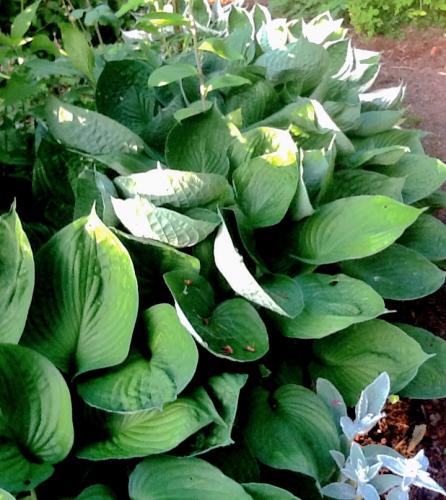
( photo / image / picture from Jewell's Garden ) Last edited: Fri Jun 27, 2014 6:09 pm This blog entry has been viewed 390 times
Base of Huglekultur Completed
Category: Starting and Maintaining the Garden | Posted: Tue May 27, 2014 1:23 pm Spent three days of adding bricks and moving soil attempting to level the ground on the north side of the huglekultur this long weekend. Because of the slope of the land it took a few more bricks than I imagined. Good news is "all miscellaneous bricks from around the yard are now in use". I am hoping that the extra dirt thrown on top of the Huglekultur will take care of a few hiding slugs. The slugs feasted on the four pots of cucumber starts I initially planted. I have several other pots waiting on my potting bench, but I will wait until the plants are much bigger before setting them in the ground. I did scatter seeds for several variety of greens. The sunflower seeds are also planted. I put them along the fence in the new narrow bed on the north side of the Huglekultur. (The sunflowers are where the bent bamboo stakes are.) 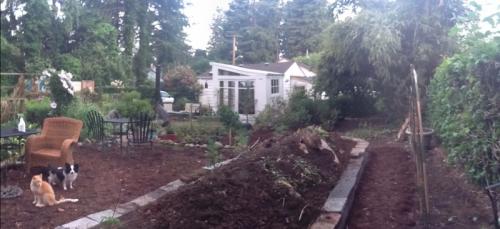
Looking toward the house from far corner ( photo / image / picture from Jewell's Garden ) 
Newly finished Huglekultur ( photo / image / picture from Jewell's Garden ) I still have a good deal of leveling and dirt hauling to do. My potting bench is sitting on a slope and I have a few more shutters to put together to help hide the clutter. I am satisfied with my progress and just wish I had more days off to complete this corner of the yard. This blog entry has been viewed 393 times
The Hugekultur Bed
Category: Starting and Maintaining the Garden | Posted: Sat May 17, 2014 3:30 pm The area was once a little shady spot filled with plants 
Filbert shade garden prior to removal ( photo / image / picture from Jewell's Garden ) In the previous posts you can see the mess that was left. I am still struggling with tidying up this area, containing the Hugelkultur leveling the area. It was a lot of work just moving a variety of ferns, and hellebores. I have moved my blue potting bench into the area and it houses pots of seeds sprouting for the Hugelkultur and the other area covered in cardboard that is also in transition from shade to veggie garden. 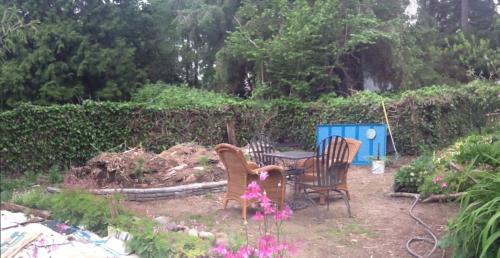
Sixth Month Marker of Hugelkultur ( photo / image / picture from Jewell's Garden ) So far I've only planted three tomato plants at the base and scattered nasturtium seeds over the top to cover up the ugly for this summer. I still have to level around the back and that dirt will finish covering the wood and logs on the back side. So far it has been a good solution for a huge eye score that would have cost a bunch and put organic matter in the land fill. One day it may be a great big raised veggie bed. This blog entry has been viewed 317 times
The Answer Is.....Hugelkultur
Category: Starting and Maintaining the Garden | Posted: Wed Apr 09, 2014 3:58 pm Ever since we took out the filberts last summer I have struggled with moving plants I wanted to save and how best to transition this 15' x 20' section of yard. A rich man would have had the stumps ground down and all the wood hauled off or neatly put into proper lengths for the wood stove and stacked. Well that is not going to happen. 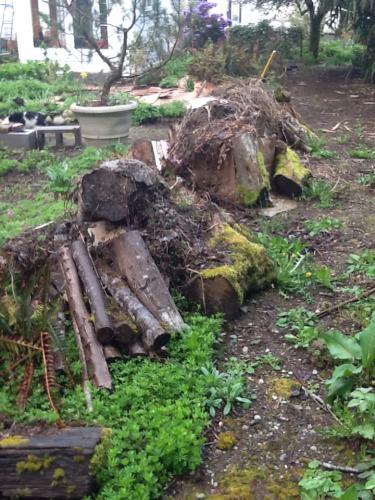
Filbert remnants ( photo / image / picture from Jewell's Garden ) 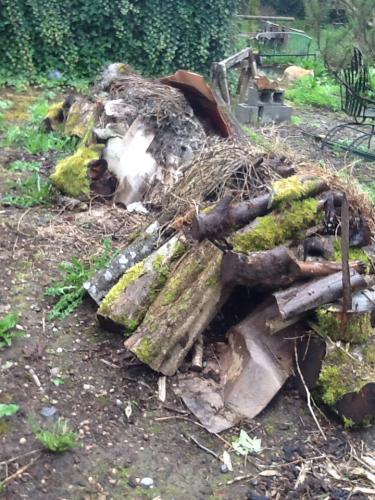
Stumps covered ( photo / image / picture from Jewell's Garden ) Right now we are living with the ugly. I am pawning off fern leaf bleeding hearts by the box load and watching out for filbert sprouts from the stumps. Luckily one of the stumps was dead from the filbert blight. Unfortunately the other two are languishing under covers of cardboard, dirt and logs too long to go in the wood stove. Having a little vacation from work has provided me with opportunities to actually read some of the blogs I subscribe to and there was my answer (big, huge smile from ear to ear). A blog by Erica entitled "Half-Ass Hugelkultur". http://www.nwedible.com/2012/03/half-ass-hugelkultur.html Hers was the spark that lead to checking out this idea. Wonder of wonders I already have the base started. I now have a vision for the area...well still half baked, but the idea is developing. I'll continue to mull over the logistics, but everything I have read makes perfect sense. Now like Erica I will have to find a way to pretty it up after the foundation is laid. Maybe bricks to outline the base and definitely mulch to cover the top surface. Humm...what are your gardening plans for this summer? Last edited: Sat May 17, 2014 3:31 pm This blog entry has been viewed 515 times
ReDoing, Creating, Maintaining Garden Beds and Paths
Category: Starting and Maintaining the Garden | Posted: Thu Jan 02, 2014 6:25 am Mild weather has helped me to trek out into the yard. With the filbert trees gone....kind of (still have large trunks to deal with) I started planning beds. Moved a lot of hellebores, ferns, and trilliums last summer fall. The trouble is I am not sure exactly where I moved every plant and found a few in unexpected spots. Then as I was organizing last summers photos I realized I had moved/planted a skimmia japonica almost on top of a hosta. Will wait until spring to find out exactly how close. 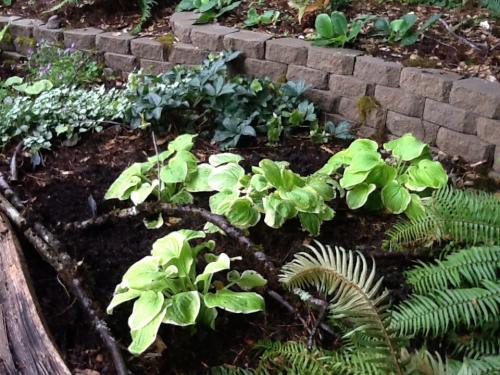
Hostas during summer ( photo / image / picture from Jewell's Garden ) 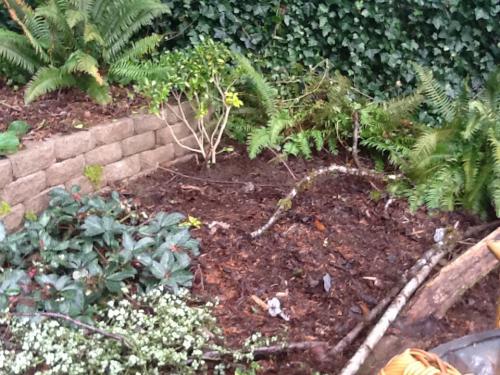
Skimmia moved to same bed..oops ( photo / image / picture from Jewell's Garden ) Got cardboard and mulch covering the one almost emptied bed. There was a lot of sweet woodruff that is being smothered. There was a path running through this area so I hope to have two veggie garden beds dividing it along the old path. Two blueberry bushes were placed in a front corner where hellebores, Pacific bleeding hearts, still live. 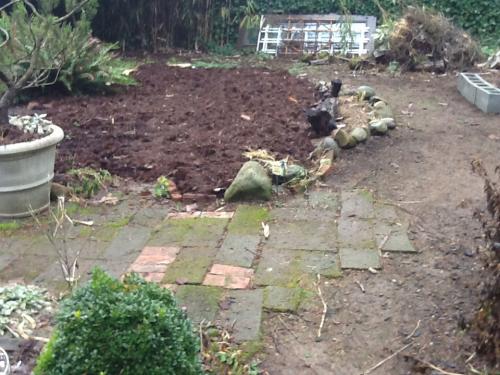
Remade woodland bed for veggies ( photo / image / picture from Jewell's Garden ) Should move another large sword fern to continue the bed redo. It is just a lot of heavy work so I am procrastinating. Would give me one more place for another blueberry bush. The filbert trunks were drilled, holes filled with epson salt, and covered to block out all light. They look awful. I wanted to uncover one and see if it was working, but will forgo the impulse until late spring or I have lots of extra energy. Last summer I started collecting cinder blocks for a raised bed. I laid out the ones I have to judge how many more I'll need. 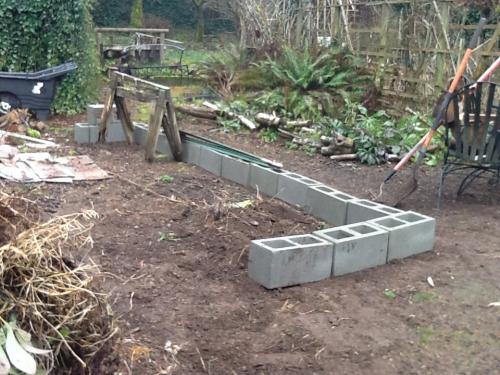
Plans for a raised veggie bed in the making ( photo / image / picture from Jewell's Garden ) I didn't harvest the bamboo the last two years. While out working on other projects I noticed ithe bamboo was starting to run. Not a good thing. Thirty years and now it is deciding to get naughty. Oh well, some heavy pruning is definitely needed. One more chore to add to a very long list. Want to move some phlox to fill in some late summer flowering holes, weed out some buttercups, clean perennials out of the paths, remulch paths that are getting muddy, hedging some ivy fences, divide perennials and that is just the back yard. Whew! Lots to do. Hope your gardening work is light, and that it has all the results you want. 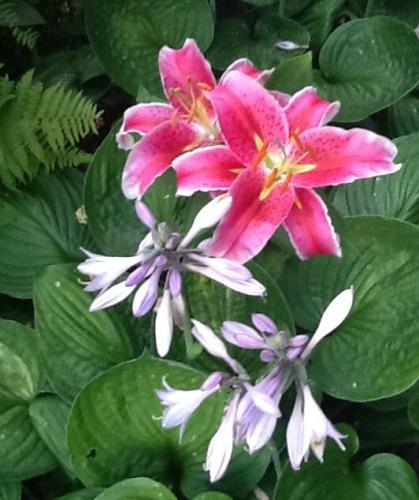
Last summer's surprising successes ( photo / image / picture from Jewell's Garden ) This blog entry has been viewed 502 times
Gardening Can Have Different Faces
Category: Ramblings | Posted: Sat Nov 16, 2013 6:42 am Fall is always a crazy work time for me. No matter how much time I spend in spring and summer setting curriculum, files and spreadsheets the influx of new students in fall over whelms the daily necessities of the job and Federal paperwork. I absolutely love what I do and love the kids I work with. As a special education teacher in an elementary school no year is ever the same. We have a high mobility rate and 70% or more of our students live in poverty. Many are working families at minimum wage jobs. Many of the children's only meals are gotten at school some days. No matter how our country bashes teachers and the school system I feel like I work with some of the best teachers that are the most caring, hard working people around. Tonight was a fund raiser, a spaghetti feed put on by staff and community members. Staff sold, donated and bought meals and deserts as well as donating time well beyond their regular work day. This is just one of many things that staff does throughout the year to extend and tie the school and community together. Our Arts and Craft Night is the next 13 hour day. Before that many of the neediest families will get food boxes for Thanksgiving and some will be taking home backpacks with food for getting through the week-ends. This group of hard working professionals apply for grants, use connections to community organizations and dig into their own finances to make sure students and their families can have the necessities for school. Fund raisers like tonight's also go to fund field trips and school equipment. The thing is, I don't believe that the school I work at is any different than any other school. It isn't a job that is done for the money. My husband makes double what I do, and we would be in a total different situation if we had to live on only my salary. There are far too many teachers I know having to work two jobs. With funding cuts and economic tough times please don't complain about schools. Go to your local school and volunteer to read with a student or two on a regular basis. You might be surprised at the change it can make for a child and maybe you too. It can be like tending and watching your garden grow. This blog entry has been viewed 671 times
A Few More Woodland Plants Added
Category: Starting and Maintaining the Garden | Posted: Sat Oct 05, 2013 7:58 pm We put our cabin on the market. I doubt it will sell since the economy is so bad. Just in case we get lucky and it does find someone to love it as much as we have I have been transplanting my favorite woodland plants to our home in town. It is nice to be able to enjoy them on a daily basis. 
Cabin in the rainforest ( photo / image / picture from Jewell's Garden ) A lot of trilliums come up in the area we keep mowed so I dig a few baby plants each time we go up. Was able to get six whole plants. Not an easy task. I have to use an old fork to tease around the glacial till trying not to break the stem off the bulb. I've gotten much better at it with practice. My woodland garden in town will one day have quite a spring time show of trilliums if I am lucky. Up at the cabin I'd stuck some of the vanilla leaf (Achlys triphylla) in a large pot with sword ferns eight years ago. The plants had been uprooted when we replaced the back door deck. Figured someone else might just think they were weeds and wanted them somewhere at home. The soil was light and perfectly damp in the pot so all I had to do was reach in and unearth the roots. Ended up with almost a dozen starts. Two or three years ago we had our first chanterelle mushroom show up in the back of the cabin. We haven't been up in the fall for the last two years. The chanterelle patch had really grown. It probably won't work but I also tried unearthing a number of the mushrooms to see if they might grow in our woodland area if I stuck them into the soil with their minuscule bottom parts. It would be fun to have the morels in the spring and the chanterelles in the fall right here at home. Mushrooms for the seasons. 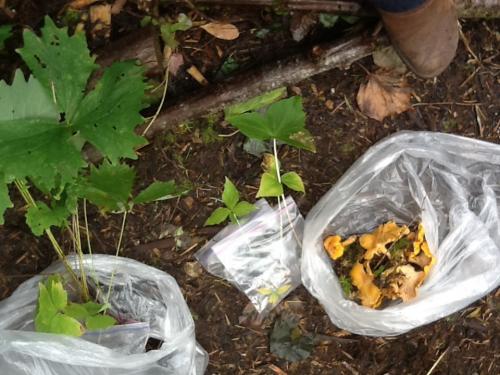
Vanilla leaf (Achlys triphylla), pacific trillium, chanterelle mushrooms ( photo / image / picture from Jewell's Garden ) It was good that I was out digging in the garden. Unlike other places where I had planted sweet woodruff, it seems the woodland area it will be a problem. Huge mats had formed for it to take off next spring. It will definitely smoother some plants so will have to be removed. Fortunately there are paths to keep it contained and is very shallow rooted and easy to pull. All in all the woodland area is coming along. I will rethink my ground covers and maybe try the little yellow violets as a ground cover instead of the sweet woodruff. I haven't had an area I thought they would be successful until now. 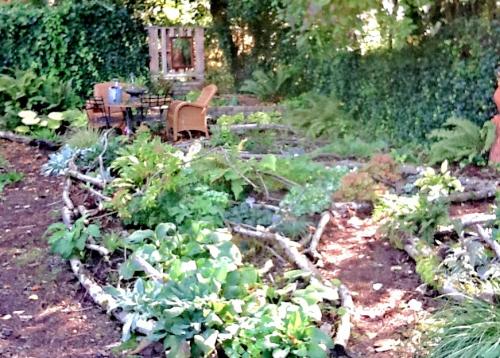
( photo / image / picture from Jewell's Garden ) 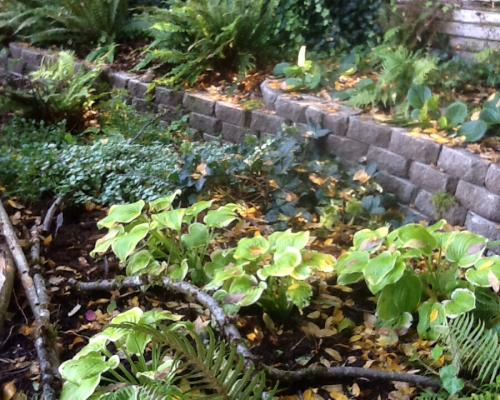
Hosta, hellebores, sword ferns, pigsqueak ( photo / image / picture from Jewell's Garden ) 
( photo / image / picture from Jewell's Garden ) 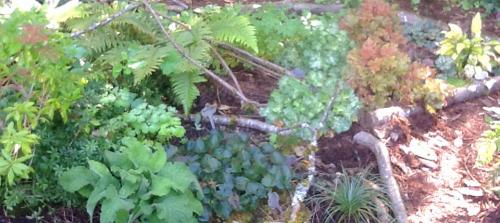
( photo / image / picture from Jewell's Garden ) But then again it appears plants are really filling in and I may need to do some redesigning of beds to accomplish what I want. The fall leaves are beginning to litter the ground and the fir needles have been mulching beds and paths since the last storm shook them from the trees. I continue to make plans and see the chaos in my garden as I seek a little order. It is not easy to make a man made woodland garden combining natives and ornamentals. It is nature perpetually in motion. Guess that is what makes gardening either an everlasting joy or an unending chore. Maybe a little of both. lol I am certainly addicted to the nature of it. This blog entry has been viewed 477 times
Night Soil, Composting Toilets, Social/Political Correctness
Category: Ramblings | Posted: Sat Sep 07, 2013 6:54 am I think I first started coming across alternative methods of dealing with human wastes when I was looking for creative outdoor sheds. The small house movement seemed to have cleverly built small spaces. Who would have thought that looking for what is basically an adult play house would lead to introspection about human bodily waste? My granddad had an outhouse out on his property away from the house, next to the horse corral. Those are now pretty much illegal except for a few Forest Service ones in national forests. The composting toilets are finding a niche. From what I can determine the human litter boxes with fans are preferable to sheds with holes in the ground. I read, saw (you tube) one household's small living space with an illegal (for this municupality) composting toilet. Thinking of all the trouble and expense of adding a second bathroom to our old home I can begin to understand the appeal. In the arid southwest they have city/county codes defining acceptable composting toilets. A small community, I believe in Spain, separated urine and feces at the community latrine for garden and composting. What about cholera, parasites and other unhealthy aspects of human waste? Somewhere I read two years of composting takes care of that, but I'm not sure it was a reliable site. But how does that compare to my grandad's outhouse? In many parts of the world night soil was a part of agricultural practices. The actual practices were more of a fermentation of the waste than composting from what I read. (Tying in with my bokashi. Actually this may have lead to my discovery of using the bokashi method of recycling household wastes, but I can't remember for sure.). When I first heard about the use of night soil I thought the poor farmer's just took it out to the fields and dumped it every day. Actually the night soil was collected "and stored in large ceramic tanks or water-tight slate-lined or concrete pits." They added livestock manure and fermented mulch like what I am doing with table scraps. As fresh water becomes less plentiful I wonder if my/our attitudes about mixing human wastes with heavy metals (what happens at the sewage treatment plant) will change. If many sewage treatment plants are recycling the waste to turn it back into drinking water is there a better way? Why don't we think of better ways to conserve water? As a society we have gotten so removed from our own bodily functions that even the use cloth diapers for babies is unheard of for a generation now. I guess I just find it all baffling. I also understand my own cultural aversion to peeing in the garden LOL. Grandad's outhouse was also fine in the summer, but scary in the long, cold winter nights. Composting toilets fad or wave of the future. Read the last link before you decide. As one forum writer reminded me, "the grass is always greener over the septic". http://www.agroecology.org/Case%20Studies/nightsoil.html http://www.agriculturesnetwork.org/magazines/global/wastes-wanted/safe-use-of-treated-night-soil http://www.tigerdroppings.com/rant/display.aspx?p=25581424 http://science.kqed.org/quest/audio/toilet-to-tap/ http://www.theguardian.com/environment/2009/may/12/humanure-composting-toilets Edited: Laura Allen's composting toilet system is explained in this YouTube video. https://m.youtube.com/watch?v=tdN_3x8VNCY&feature=plpp. Guess I have an 8 year olds fascination with poop and pee Last edited: Sat Sep 07, 2013 4:46 pm This blog entry has been viewed 934 times
You're reading one of many blogs on GardenStew.com.
Register for free and start your own blog today. |
Entries by Category
All Categories
|
